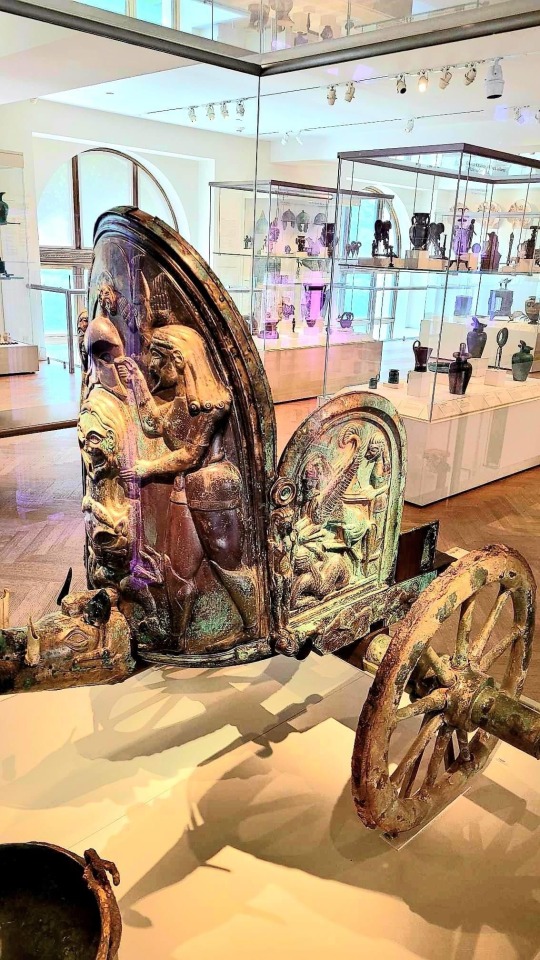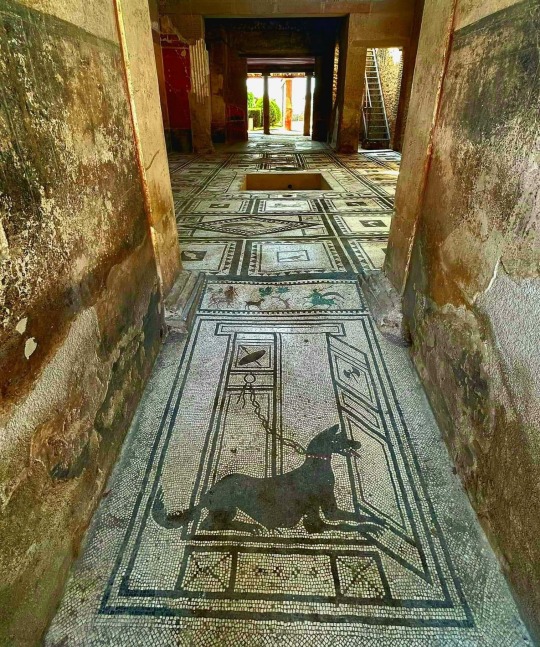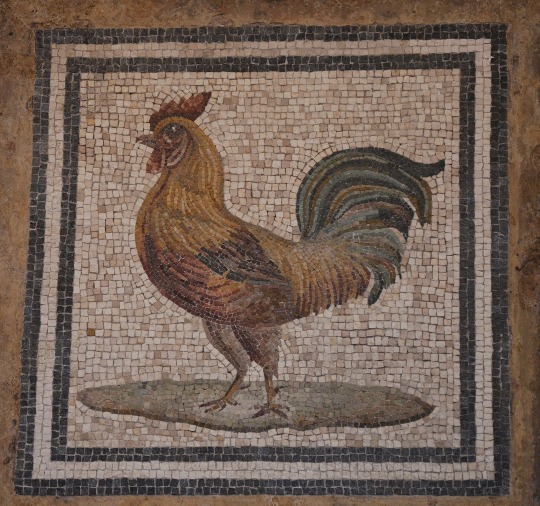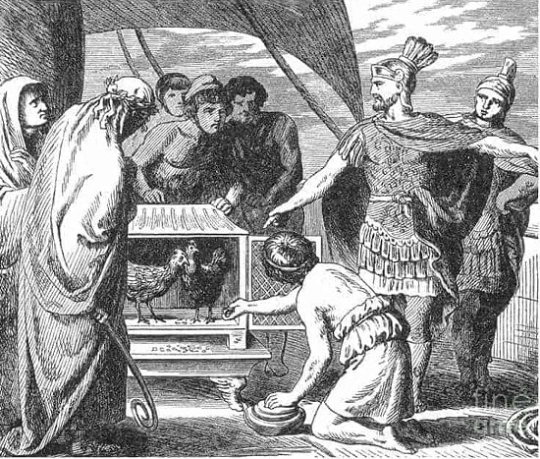#ancientromanhistory
Explore tagged Tumblr posts
Text

The stunning Etruscan war chariot ca 6th Century BC photographed by Jason Martinez Photography. The Monteleone chariot is one of 6 known to remain in this condition and was undoubtedly used to accomodate a driver and a highly distinguished individual. Made of bronze with heavy useage of ivory inlays, Achilles and other Homeric scenes adorn this beautiful piece. The wheels are rather significant as they are wooden but covered with bronze to prevent damage, an expensive and unusual practice. It is on display at the Met, NY.
**Please LIKE and FOLLOW**
Photo: Jason Martinez Photography
#jasonmartinezphotography
#dansromanhistory #romanrepublic #romanhistory #romanempire #rome #ancientromanhistory #ancienthistory
1 note
·
View note
Text

One of the many "Cave Canem" or beware dog warning mosaics that met you when entering certain houses in Pompeii. Some show the dog chained while others appear to be allowed to roam free. This is a taller, leaner breed with a short coat and long sharp teeth while others have a long coat and are heavyset. The images above the dog show hunting scenes with the same looking dog so assumptions could be made that a vicious hunting dog guards this family.
Photo: Public Domain.
#dansromanhistory #romanempire #romanrepublic #ancientromanhistory #romanhistory #ancienthistory #pompeii
Source: Facebook
Dan’s Roman History
0 notes
Text
Consulting the Coop: Ancient Rome’s Sacred Chickens and Big Decisions
When faced with a decision there are typically two ways to proceed, you evaluate the options for yourself and choose the best avenue or you might feel the need to ask advice from a trusted source. This source can be anyone, a relative, friend, coworker, counselor, or…if you were living in one specific timeframe…you headed right for the chicken coop.
Ancient Rome can conjure majestic images of architecture, artwork, and bring to mind familiar names of great intellectuals and mighty leaders like Caesar, Cicero, Marcus Aurelius, Claudius, and Augustus. Considering how immense and powerful Rome was, it might be surprising how reliant it was on superstition and reading “signs” given to them by the gods. The Romans often took part in augury, using the outcome of various practices and rituals as predictions of the future. Some practices involved reading the entrails of animals, some may have looked at plant leaves, others may have studied storms, but one of the most common forms of this type of divination involved birds, and in ancient Rome the most vital of these birds were chickens.
After being relocated from their home near Athens, the chickens were tended to by a pullarius, a “priest of the sacred chicken”, and it was these priests that became responsible for some major decisions in Roman history. The process was straightforward, the chickens were kept in pens and were denied food for a certain amount of time. When there was an important decision to be made the pullarius fed the chickens grain. If the hungry birds ate the grain it signaled a “yes” to the question. But, if they did not eat it was a definite “no” and it was highly advised that a new avenue be considered.
But what if they did not listen to the chickens? What could possibly go wrong? The birds were presented with questions on every level, including ones that carried an immense amount of weight and heavy consequences for Rome. On more than one occasion they were not listened to and those who defied the sacred chickens were left with deep regret.

Ancient Roman mosaic of a rooster. Image commons.wikimedia.org.
At the beginning of the First Punic War (264-241 BCE) the Roman navy’s biggest obstacle was the far superior naval force of Carthage that boasted better ships and more advanced sailors. One thing that Rome did have in its favor was a gift for engineering and tactics which eventually gave them a fleet of ships that could challenge the Carthaginian ships. By 249 BCE the fleet of 123 ships had a number of impressive victories under its belt and was under the command of Publius Claudius Pulcher. When Pulcher successfully cornered the Carthaginian navy in the harbor of Drepanum he had two options, to sit in wait creating a blockade or, his preferred choice, to launch a surprise attack. He knew who he had to ask. Pulcher happened to have some sacred chickens on his ship, but their reaction to his inquiry did not please the admiral. They refused to eat the grain given to them…an ambush was not advised.
Pulcher’s next step would have appalled many in Rome. The chickens very clearly advised him not to attack the Carthaginian fleet. But, not only did he go against the chickens, he may have outright disrespected them. According to some records, when the birds refused their grain he said to his crew “If they will not eat, let them drink!” before throwing them into the sea.
The attack on the fleet of Carthage was devastating for Pulcher. Of the 123 ships he brought into battle only 30 survived and up to 20,000 men were lost, decimating the Roman navy and destroying all the headway and moral they built during their previous victories. Pulcher survived the ordeal but when he returned to Rome he was heavily fined for his actions and accused of treason.

An illustration of Pulcher consulting the sacred chickens. Image via https://www.weirduniverse.net/blog/comments/sacred_chickens_of_rome
In the year 137 BCE Gaius Hostilius Mancinus was the Roman consul during the Numantine War. Before engaging in a campaign against the Numantians in Spain Gaius went to consult the sacred chickens about his plans. There were typically two outcomes here, the chickens ate the grain or they did not. This time however, the chickens did not even consider the grain. Instead they ran straight into the surrounding woods and could not be found. This should have been a very clear answer to Gaius telling him his campaign was not looking favorable. But instead, he went on to battle. What followed was a military disaster for Gaius. They were beaten in battles several times over, they failed to build a camp, and by daybreak they were completely surrounded by the enemy. The situation could have spelled utter doom for the Romans, but among them was the son of a man named Tiberius Sempronius Gracchus, a man the Numantians were familiar with and held in high regard. To save thousands of lives Gaius had to agree to a peace deal with his opponents, sending him and his army crawling back to Rome and leaving all of their belongings behind. When Gaius appeared before the Senate, they were furious with him and the embarrassment of his dealings with the Numantians. Gaius was stripped naked, put in chains, and the new Roman consul was ordered to bring him back to the Numantians in Spain. Once there, they refused to receive him. Gaius eventually returned to Rome where he lived out the rest of his years forever marked with humiliation. Plutarchus later dubbed him “the most unfortunate of the Romans.”

The sacred chickens of Rome in their coop from an engraving of military insignia and instruments of war by Nicolas Beatrizet. The full engraving is found at Speculum Romanae Magnificentiae, [Image no. B293], Special Collections Research Center, University of Chicago Library.
Tiberius Gracchus was a controversial Roman politician for his time. While serving as Tribune of the Plebs he proposed a land reform bill that sought to transfer land from wealthy landowners to poorer citizens, much to the chagrin of the Senate. By 133 BCE Tiberius was seeking a second term to continue his cause and on the day of the election he traveled to Campus Martius for the vote. Before leaving though he made sure to consult the family chickens to ask if he should attend at all. The chickens told him he should not go. He should have listened to them.
Things soon began to go bad for Tiberius. As he left his house he stubbed his toe badly, bloodying his shoes as he continued to the assembly. When he arrived at the Capitol he was informed of some dire news, that some opponents in the Senate had hatched a plan to kill him. Arming themselves with anything they could find, Tiberius and his followers braced themselves. In the massive crowd it is said Tiberius pointed to his head to signal he was in danger, but his enemies took the sign as him saying he wanted to be crowned king. The heated senators had had enough. They and their followers armed themselves and headed for Tiberius and his supporters. What followed was the eruption of a massive riot that resulted in the deaths of approximately 300 people. One of the dead was Tiberius, he had been beaten to death and his body thrown into the Tiber. The death of Tiberius, the blatant murder of an elected official, was shocking and it marked the beginning of the end for Rome.
As Rome transformed over time, moving from Republic to Empire, their methods and customs changed. While augury remained a presence in Roman culture the practices moved away from the sacred chickens until eventually divination as a whole became frowned upon with the onset of Christianity.
Today anyone looking for answers through divination has many methods to choose from ranging from decks of cards to reading animal bones and everything in between. Greatly missing from today’s list of options are the sacred chickens, the common birds responsible for some of the biggest moments in Ancient Roman history.
**********************************************************
Sources:
The Sacred Chickens of Rome by Paul Sheridan https://www.anecdotesfromantiquity.com/the-sacred-chickens-of-rome/
The Sacred Chickens of Rome https://www.weirduniverse.net/blog/comments/sacred_chickens_of_rome
The Sacred Chickens that Shaped Roman Decision-Making by Alexander Meddings https://historycollection.com/sacred-chickens-shaped-roman-policymaking/
The Disgraced Ancient Roman Admiral Who Did Not Heed The Sacred Chickens During The First Punic War https://thehistorianshut.com/2018/09/14/the-disgraced-ancient-roman-admiral-who-did-not-heed-the-sacred-chickens/
History with the Szilagyis Episode 3: The Sacred Chickens of Rome https://historywiththeszilagyis.org/hwts003
#HushedUpHistory#featuredarticles#history#historyclass#AncientRome#AncientRomanHistory#chickens#divination#augury#predictthefuture#HistoryofAncientRome#SacredChickens#AncientRomanMilitaryHistory#predictions#sacredanimals#chicken#historicchickens#historicanimals#animalsinhistory#historyisweird#weirdhistory#strangehistory#forgottenhistory#historyiswild#historyisfun#truthisstrangerthanfiction#truestory#psychicchickens#whataretheodds#goodadvice
6 notes
·
View notes
Photo

What are you all reading? 📚 📖 👓 📕 📘 Authors: Sohrab Ahmari, Geraldine Pinch, Mary Lefkowitz, James Romm, and Toby Wikinson #tobywilkinson #marylefkowitz #jamesromm #geraldinepinch #sohrabahmari #book #literature #writing #english #greek #roman #islamic #religious #mindful #chaos #greece #ancientgreece #ancientrome #ancientromanhistory #ancientgreekhistory #books #author #histories #mythology #egypt #ancientegypt #ancientegyptianhistory (at Broken Arrow, Oklahoma) https://www.instagram.com/p/CezeA8zszKV/?igshid=NGJjMDIxMWI=
#tobywilkinson#marylefkowitz#jamesromm#geraldinepinch#sohrabahmari#book#literature#writing#english#greek#roman#islamic#religious#mindful#chaos#greece#ancientgreece#ancientrome#ancientromanhistory#ancientgreekhistory#books#author#histories#mythology#egypt#ancientegypt#ancientegyptianhistory
0 notes
Photo

Here’s another snippet of a big thing soon to be revealed. And, again, since there are no cats on this structure, please enjoy the pic of me in a heated debate with Bella over who was better: Pliny the Elder or Pliny the Younger. #squarepaws #cattowers #catcafe #southbeach #plinytheelder #plinytheyounger #tacitus #ancientromanhistory #beachlife https://www.instagram.com/p/BoOtbkBBia6/?utm_source=ig_tumblr_share&igshid=inydssc2dygg
#squarepaws#cattowers#catcafe#southbeach#plinytheelder#plinytheyounger#tacitus#ancientromanhistory#beachlife
2 notes
·
View notes
Photo

Did someone say Roman ruins? #historybuff #ancientromanhistory #Lyon #southernfranceroadtrip #1stdayexploring #hotday #summerholidays #exploring #finallytravellingagain #timeoff (at Lugdunum - musée et théâtres romains) https://www.instagram.com/p/CDhOLBHAtwv/?igshid=927npdcr50w2
#historybuff#ancientromanhistory#lyon#southernfranceroadtrip#1stdayexploring#hotday#summerholidays#exploring#finallytravellingagain#timeoff
0 notes
Photo

A carving on a plinth at the mighty Capua Amphitheater photo©jadoretotravel #jadoretotravel #capua #amphitheatre #romanamphitheatre #santamariacapuavetete #ancientromanamphitheatre🏰 #ancientromans #ancientromanlife #whatdidtheromanseverdoforus #snakes #romansnakes #snakecarvings #drivingitaly #italianroadtrip2019 #ancientromanhistory #lifeinblackandwhite #exploringitaly🇮🇹 #exploringancientitaly #exploringitaly🚖👣 (at Anfiteatro S Maria Cv) https://www.instagram.com/p/B6c4SxGJSVv/?igshid=1w0jj45hsz0ae
#jadoretotravel#capua#amphitheatre#romanamphitheatre#santamariacapuavetete#ancientromanamphitheatre🏰#ancientromans#ancientromanlife#whatdidtheromanseverdoforus#snakes#romansnakes#snakecarvings#drivingitaly#italianroadtrip2019#ancientromanhistory#lifeinblackandwhite#exploringitaly🇮🇹#exploringancientitaly#exploringitaly🚖👣
0 notes
Photo

She knows me well! #archaeology #museum #ancientromanhistory #historybuff #exploring #Germany #weekendsaway #cookingpots #deathruns #reconstructions #travellife #nannylife #imfree (at LWL-Römermuseum Haltern am See) https://www.instagram.com/p/CCQ3ehdA7jL/?igshid=1ghx4vewlvfca
#archaeology#museum#ancientromanhistory#historybuff#exploring#germany#weekendsaway#cookingpots#deathruns#reconstructions#travellife#nannylife#imfree
0 notes